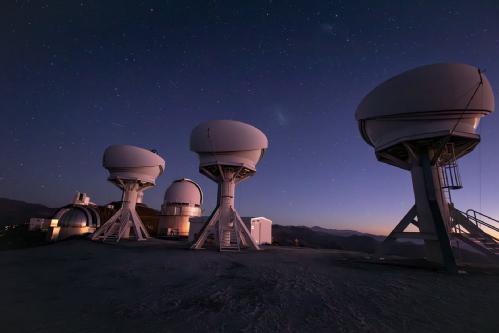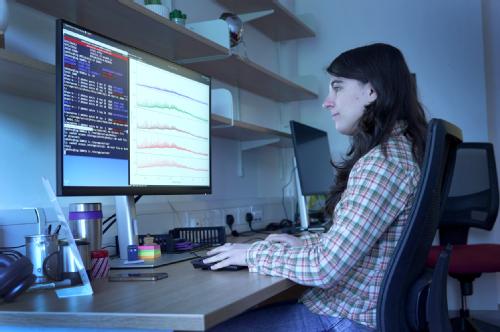An astronomer from the University of Warwick is to investigate an intriguing type of star system to help drive our understanding of the expanding universe.
Dr Ingrid Pelisoli, has received a £1.2 million grant from the Royal Society to pursue her research, which will be analysing binary star systems. These are two stars sharing an orbit, too close to each other for the human eye to separate them. She will particularly focus on white dwarf binaries, which have enabled astronomers to measure the expansion of the universe.
Dr Pelisoli, who is working with collaborators at the University of Sheffield on the project, said: "When you look up to the night sky, a large fraction of the stars that you see are actually binary systems. This includes Sirius, the brightest star in the sky, a pair containing a main sequence star, like our Sun, and a white dwarf, a fossil of stellar evolution. These binary systems containing a white dwarf are the main subject of my research."
To complete her research, Dr Pelisoli is joining the BlackGEM Consortium, which hosts three state-of-the-art telescopes in Chile, operated by a consortium of universities, looking deep into space across a large area of the night sky. BlackGEM – which is led by NOVA (Netherlands Research School for Astronomy), Radboud University and KU Leuven – is building a multicoloured movie of the Southern skies to search for variable stars and transient events.

Why are binary systems so important?
Binary systems are important for several reasons. Firstly, they are the progenitors of supernovae explosions that enable scientists to measure the accelerated expansion of the Universe.
Dr Pelisoli said: "We have known for many years now that the Universe is expanding at an accelerated rate. This finding relies on a type of stellar explosion called supernova type Ia (SN Ia), which occurs when a white dwarf star in a binary system gains too much mass to sustain equilibrium and undergoes thermonuclear explosion. We know in theory that this is what happens, but we have not observed the progenitor systems of this explosion yet. In other words, we know what should be exploding, but we cannot find it. One of the aims of my research is to systematically search for the progenitors of type Ia supernovae."

Binary systems are also sources of gravitational waves, noted in ground-breaking research which was awarded the Nobel Prize in Physics in 2017.
"The gravitational waves that we have directly detected so far were caused by black hole and neutron star binaries, which are very rare types of systems," added Dr Pelisoli. "The reason they have dominated detections is simply a selection effect: the instruments currently in operation, like the Laser Interferometer Gravitational-Wave Observatory (LIGO), are only sensitive to these systems.
"In reality, white dwarf binaries are much more abundant. Their gravitational waves will be detected by a future mission called Laser Interferometer Space Antenna (LISA), a triangular array of lasers in space that will start operations in the 2030s. White dwarf binaries are so abundant that their gravitational wave signal will affect the detection capabilities of LISA. But we don't know by how much, because our understanding of the binary white dwarf population is still limited. My research will address that, enabling us to characterise the capabilities of LISA."
Finally, the evolution of white dwarf binaries can give origin to populations of stars with extreme properties that challenge current astrophysical models.
Dr Pelisoli added: "Binary stars are abundant enough that there are entire stellar populations that only exist because of interaction in binary systems. This includes: hot subdwarf stars, which are stripped cores of red giants; blue straggler stars, so called because their evolution has been delayed by a companion; Barium stars, which show unusual levels of the element Barium – and many others. By providing an accurate census of the binary white dwarf population, my research will help us understand better the formation scenarios for all of these peculiar populations."
The research project will be observational in nature, with Dr Pelisoli and her colleagues using different types of data to characterise the galactic population of white dwarf binaries. They will first identify candidate white dwarf binaries using data from the groundbreaking Gaia satellite, which has measured the parallax (an indirect measurement of distance) and the apparent brightness of over a billion stars.
Combining apparent brightness and distance, the intrinsic brightness of a star or stellar system can be estimated. Astronomers use that to infer the nature of the detection – if it's likely to be a white dwarf and if it might be a binary.
Dr Pelisoli continued: "We will analyse the spectra of these stars to understand more about their composition. With spectra, the light of each system is separated into wavelengths, and from the resulting brightness profile we can infer mass and temperature of a star. We can also check whether it has a companion, because the orbital motion will shift the detected light to redder or bluer wavelengths as the stars move (similar to how the pitch of the engine of a racing car changes as it moves further away or towards us). Finally, we will measure the orbital periods of the identified binaries by tracking their movements.
"The expansion of the Universe is my favourite topic to explore. For example, to understand whether it will keep expanding indefinitely or stop and retract eventually. To answer this problem, we need to understand its stellar population, in particular the white dwarf binaries that allowed us to measure this expansion in the first place."
Dr Pelisoli is recognised among the 39 University Research Fellowships, seven Dorothy Hodgkin Fellowships, and 39 Newton International Fellowships awarded to outstanding scientists with the potential to become leaders in their fields. The long-term, flexible funding schemes provide researchers with the stability and support required to pursue innovative, cutting-edge scientific research, form international collaborations, and establish research groups.
Across all three schemes, over £80m of funding has been allocated, a sign of the investment in world leading researchers the UK needs to become a global science superpower.






